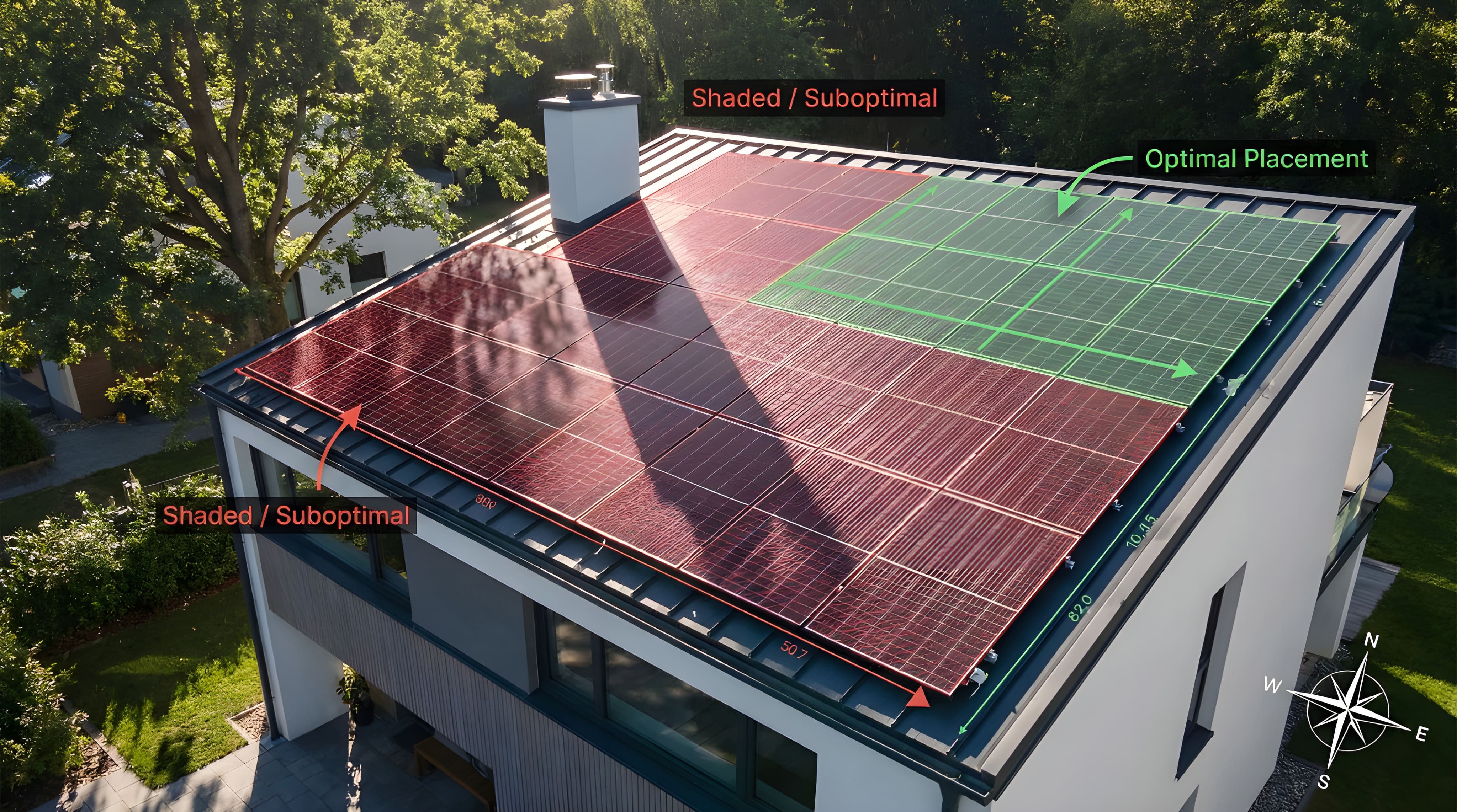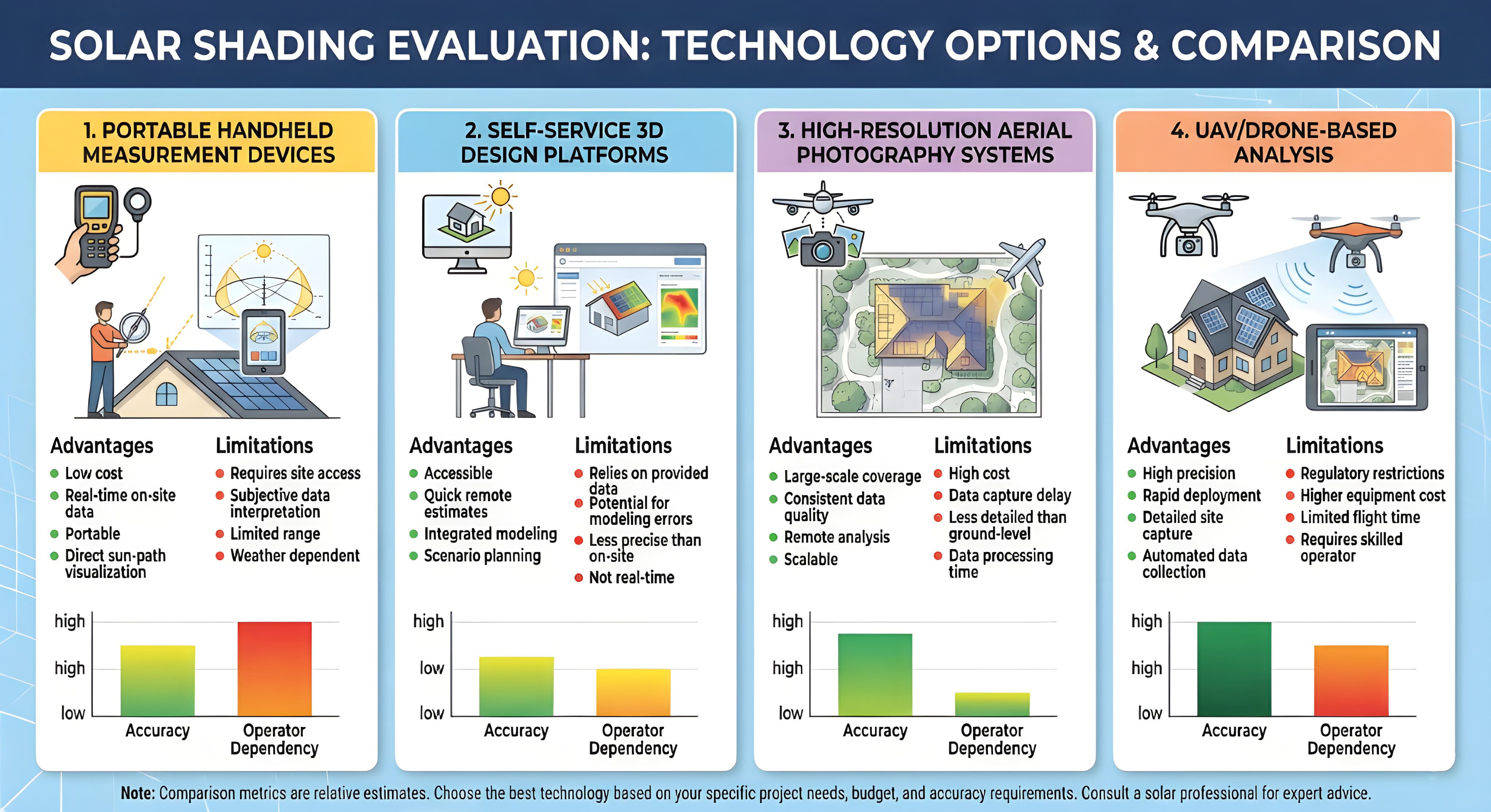

Inconsistency in shade assessments remains a widespread challenge in the solar industry.
When multiple professionals analyze the same roof using identical handheld shading devices or self-service software platforms, the results often vary significantly. These inconsistent shade reports create substantial complications for both contractors and property owners.
The degree of shading on a roof directly influences a system's electrical generation capacity, which subsequently impacts equipment selection, financial projections, and the customer's return on investment.
Many contractors remain unaware of this critical issue. Handheld measurement devices have dominated the industry for years, leading professionals to accept them without question. While numerous solar design software providers emphasize shading precision, they often overlook a crucial detail: accuracy depends heavily on user expertise. A shade assessment can determine project success or failure, particularly as solar market competition intensifies.
This article examines several aspects of shading analysis to provide comprehensive understanding. The following topics will be covered:
Direct answer: Absolutely essential.
Precision stands as the paramount requirement. The quantity of sunlight reaching a roof surface directly correlates with system financial viability.
Detailed explanation: Solar project location and funding sources influence market perspectives on shading analysis accuracy requirements. Certain state programs and financial institutions mandate specific calculation methods and establish minimum shade thresholds for project approval.
Residential installations, however, lack standardized benchmarks. The industry recognizes various shade estimation methods, but quantifying their accuracy proves challenging, leaving no definitive reference point for comparison.
A common misconception in residential solar suggests shading accuracy matters only for performance guarantees or Power Purchase Agreements. However, incorrect electricity generation estimates impact homeowner ROI and satisfaction regardless of guarantee provisions. Consumer protection has emerged as a critical concern in solar, as many property owners received promises of savings that failed to materialize.
While shading analysis precision isn't universally mandated across all solar sectors, its significance cannot be overstated. This leads to the next consideration: the financial impact of imprecision.
Shade represents the most substantial loss factor when calculating solar PV system electricity generation. Additional factors include geographic location, climate patterns, equipment specifications, and roof orientation.
Inaccurate analysis creates significant discrepancies between promised production estimates and actual output based on roof shading conditions. This mismatch profoundly affects customers and contractors alike.
Hidden costs from inaccurate shading analysis directly diminish profitability and long-term industry viability. These costs manifest as elevated customer acquisition expenses from negative experiences and reduced referral rates, plus increased labor and operational costs from change orders and project cancellations.

Accurate shading analysis enhances electricity production estimate precision, but additional benefits extend far beyond this primary advantage. Five major benefits include:
Precise shade estimation tools deliver exact calculations such as Solar Access Values (SAV) and Total Solar Resource Fraction (TSRF) derived from high-resolution aerial imagery. These metrics help designers determine optimal panel placement within PV systems to maximize energy generation.
Accurate shading assessment enables creation of dependable financial models based on system production capacity estimates. This capability helps close sales and boost customer satisfaction, as financial savings rank among the primary reasons consumers choose solar installation.
Accurate shading analysis facilitates superior system design, leading to better equipment choices regarding both solar efficiency and cost effectiveness. This reduces hard costs like equipment pricing and quantity requirements, while also decreasing soft costs by streamlining procurement processes and ensuring correct initial selections.
Many customers pursue solar installation to lower electricity expenses. Systems that meet expectations typically generate satisfied customers, resulting in increased referrals that dramatically reduce customer acquisition costs.
Residential systems lack standardized shade measurement units. Many user-operated tools generate variable results, creating a problematic combination for consumers. Accurate shade analysis using third-party verification sources protects consumers from both unscrupulous vendors and well-intentioned but inaccurate estimates.

Understanding the benefits of accurate shading analysis, several tool types exist for estimating roof surface shade.
Handheld devices have traditionally dominated industry shade estimation practices. These devices measure available solar energy daily, monthly, and annually by determining site-specific shading patterns.
The limitation of handheld devices lies in their dependence on operator skill. This dependency creates vulnerability to user error and subjective interpretation of results.
These tools estimate shade by generating 3D models from satellite or aerial imagery, sometimes incorporating LiDAR reference data.
DIY solar software can deliver quality results, but outcomes depend on user operation. User interpretation and skill level impact results, creating variation between different operators.
Aerial imagery-based tools provide the highest accuracy levels. Advanced solutions calculate shade using 3D data extracted from high-resolution aerial imagery.
A primary advantage of this tool type is elimination of user influence on results, whether intentional or unintentional. This makes advanced aerial imagery solutions third-party truth sources, validated by leading global quality assurance advisors.
These systems use digital surface models representing structures and vegetation within extensive ranges from properties, capturing measurements at frequent intervals on roofs throughout the year.
This process generates thousands of data points per roof, achieving detail levels impossible for manual replication.
As quality assurance experts note, advanced aerial imagery solutions can provide modeled solar access values at more roof locations than could be practically measured and processed manually.
Drones deliver quality and consistency comparable to advanced aerial imagery for shade analysis. However, drone usage requires scheduling external site visits (potentially limited by weather), equipment acquisition and maintenance, user training, and managing various operational complications.

Several proven approaches exist for effective shade analysis.
Most shade estimation tools perform only as well as their operators. Two main mitigation options exist: switching tools or implementing rigorous operator training. The distinction is that training reduces human error while superior tools can eliminate it entirely.
Estimating roof shade requires consideration of numerous factors, including roof obstructions, adjacent buildings, trees and vegetation, seasonal variations, weather patterns, and more. Greater information collection produces more accurate estimations.
Traditional roof inspections with handheld calculation devices collect data from 15 to 30 measurement points. By comparison, advanced solutions collect tens of thousands of data points per roof, delivering substantially more accurate results.
No shade amount is too minimal to affect electrical generation. Research demonstrates that shading on just one out of 36 cells in a small solar module can reduce power output by over 75 percent.
Shade originates from multiple sources. Some are obvious, like nearby trees and buildings, while others prove less apparent, like distant elevations. Many shade forms aren't properly captured by DIY software, making verification essential to ensure comprehensive coverage.
Beyond human error, subjectivity represents a major challenge with handheld devices. When analyzing identical data, designers may select different images for solar access percentage production and apply varying corrections for shaded area adjustments. Establishing consistency standards among users helps reduce shading loss from subjective interpretation.
Precision in solar shading analysis stands as a cornerstone of successful solar installations. The difference between accurate and inaccurate shade assessments extends far beyond simple measurements, directly impacting system performance, customer satisfaction, and business reputation.
With residential solar systems representing investments between $11,144 and $14,696 after tax credits, the financial stakes are substantial. Inaccurate shading analysis leads to failed expectations, eroded customer confidence, and potential legal action. Conversely, systems that meet or exceed production estimates create satisfied customers who become powerful referral sources, dramatically reducing acquisition costs while building lasting business credibility.
Investing in reliable shading evaluation tools and methodologies yields measurable returns through improved system design, accurate financial projections, and enhanced customer experiences. While handheld devices and DIY software remain common, their operator-dependent nature introduces variability that compromises outcomes. As solar market competition intensifies, companies prioritizing shading accuracy position themselves for long-term success through superior satisfaction, increased referrals, and reduced operational costs.
The technology exists to achieve unprecedented precision in shade assessment. The question becomes not whether accuracy matters, but whether businesses can afford to operate without it. For professional assistance with solar project planning and compliance, contact our team today.
What causes shading on solar panels?
Shading on solar panels occurs when objects block sunlight from reaching solar cells. Common shade sources include nearby buildings, trees, vegetation, roof-mounted equipment, chimneys, and even other solar panels when positioned too closely in certain installation configurations. Less obvious sources include distant structures and terrain elevations that cast shadows during specific times of day or seasons.
How does partial shading affect solar panel performance?
Partial shading significantly reduces solar panel output beyond the shaded area alone. Research shows that shading just one cell out of 36 in a solar module can decrease power output by over 75 percent. This dramatic impact occurs because shaded cells create resistance within the electrical circuit, affecting the entire panel's performance. The actual production loss depends on the PV equipment installed and whether optimization technologies like microinverters or power optimizers are used.
What methods exist for calculating solar shade?
Several methods exist for calculating solar shade, each with varying accuracy levels. Options include handheld measurement devices that capture on-site data, DIY solar design software that creates 3D models from satellite imagery, drone-based assessments requiring site visits, and advanced aerial imagery solutions that generate thousands of data points per roof. The most accurate methods eliminate human variables by relying on high-resolution aerial photography and automated calculations.
How many measurement points are needed for accurate shade analysis?
Traditional handheld devices typically collect 15 to 30 measurement points per roof, which provides basic shade estimation but leaves significant gaps in coverage. Advanced automated solutions collect tens of thousands of data points per roof, capturing readings every few inches throughout the entire year at 15-minute intervals. Higher data point density directly correlates with accuracy, as it accounts for seasonal variations, time-of-day changes, and all potential shade sources.
Can shade analysis accuracy impact solar financing approval?
Yes, shade analysis accuracy directly affects financing approval in many cases. Certain state programs, utility incentives, and third-party financiers establish specific requirements for shade calculation methods and set minimum solar access thresholds for project eligibility. Inaccurate shade assessments can result in rejected financing applications, project cancellations, or systems that fail to meet guaranteed performance requirements, creating financial liability for contractors.
Why do different tools produce different shading results?
Different tools produce varying results primarily due to methodology differences and operator influence. Handheld devices and DIY software depend heavily on user skill, interpretation, and subjective decisions about which data points to include or exclude. Variables like operator positioning, time of measurement, image selection, and correction adjustments all introduce inconsistency. Automated solutions that eliminate human variables produce consistent, repeatable results regardless of who initiates the analysis.
What shade percentage makes a solar installation unviable?
No universal shade percentage threshold determines project viability, as requirements vary by location, financing type, and program specifications. Some state programs and financiers set minimum solar access requirements, typically ranging from 70 to 90 percent annual solar access. However, even heavily shaded systems can prove financially viable depending on electricity rates, incentive availability, equipment selection, and customer expectations. Each project requires individual evaluation based on specific circumstances and performance expectations.
We are dedicated to providing top-notch solar permit services to homeowners, business owners, DIY, and solar installers. Contact us today.